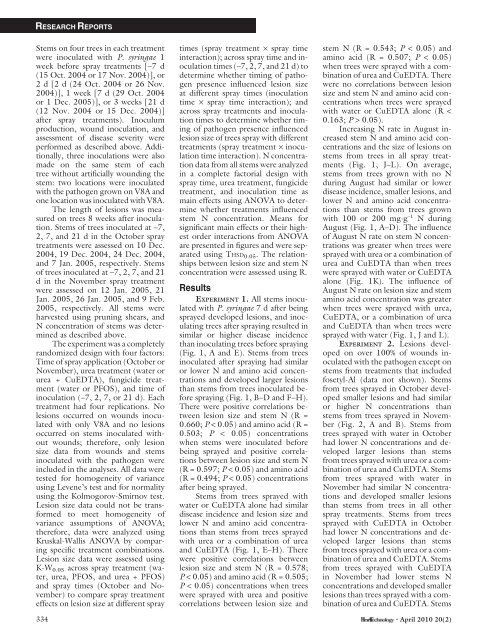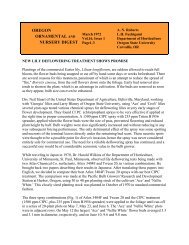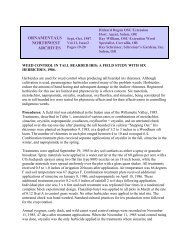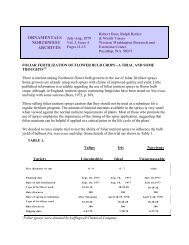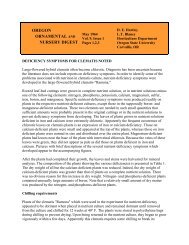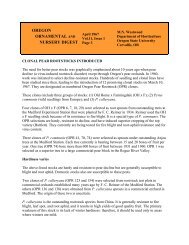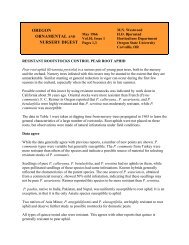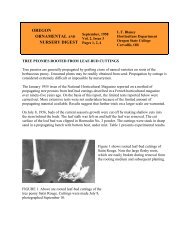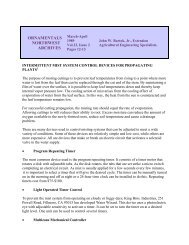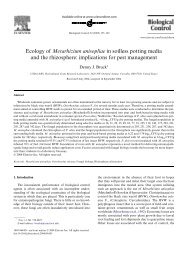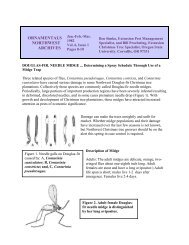Spraying Leaves of Pear Nursery Trees with Urea and Copper ...
Spraying Leaves of Pear Nursery Trees with Urea and Copper ...
Spraying Leaves of Pear Nursery Trees with Urea and Copper ...
Create successful ePaper yourself
Turn your PDF publications into a flip-book with our unique Google optimized e-Paper software.
RESEARCH REPORTS<br />
Stems on four trees in each treatment<br />
were inoculated <strong>with</strong> P. syringae 1<br />
week before spray treatments [–7 d<br />
(15 Oct. 2004 or 17 Nov. 2004)], or<br />
2 d [2 d (24 Oct. 2004 or 26 Nov.<br />
2004)], 1 week [7 d (29 Oct. 2004<br />
or 1 Dec. 2005)], or 3 weeks [21 d<br />
(12 Nov. 2004 or 15 Dec. 2004)]<br />
after spray treatments). Inoculum<br />
production, wound inoculation, <strong>and</strong><br />
assessment <strong>of</strong> disease severity were<br />
performed as described above. Additionally,<br />
three inoculations were also<br />
made on the same stem <strong>of</strong> each<br />
tree <strong>with</strong>out artificially wounding the<br />
stem: two locations were inoculated<br />
<strong>with</strong> the pathogen grown on V8A <strong>and</strong><br />
one location was inoculated <strong>with</strong> V8A.<br />
The length <strong>of</strong> lesions was measured<br />
on trees 8 weeks after inoculation.<br />
Stems <strong>of</strong> trees inoculated at –7,<br />
2, 7, <strong>and</strong> 21 d in the October spray<br />
treatments were assessed on 10 Dec.<br />
2004, 19 Dec. 2004, 24 Dec. 2004,<br />
<strong>and</strong> 7 Jan. 2005, respectively. Stems<br />
<strong>of</strong> trees inoculated at –7, 2, 7, <strong>and</strong> 21<br />
d in the November spray treatment<br />
were assessed on 12 Jan. 2005, 21<br />
Jan. 2005, 26 Jan. 2005, <strong>and</strong> 9 Feb.<br />
2005, respectively. All stems were<br />
harvested using pruning shears, <strong>and</strong><br />
N concentration <strong>of</strong> stems was determined<br />
as described above.<br />
The experiment was a completely<br />
r<strong>and</strong>omized design <strong>with</strong> four factors:<br />
Time <strong>of</strong> spray application (October or<br />
November), urea treatment (water or<br />
urea + CuEDTA), fungicide treatment<br />
(water or PFOS), <strong>and</strong> time <strong>of</strong><br />
inoculation (–7, 2, 7, or 21 d). Each<br />
treatment had four replications. No<br />
lesions occurred on wounds inoculated<br />
<strong>with</strong> only V8A <strong>and</strong> no lesions<br />
occurred on stems inoculated <strong>with</strong>out<br />
wounds; therefore, only lesion<br />
size data from wounds <strong>and</strong> stems<br />
inoculated <strong>with</strong> the pathogen were<br />
included in the analyses. All data were<br />
tested for homogeneity <strong>of</strong> variance<br />
using Levene’s test <strong>and</strong> for normality<br />
using the Kolmogorov-Smirnov test.<br />
Lesion size data could not be transformed<br />
to meet homogeneity <strong>of</strong><br />
variance assumptions <strong>of</strong> ANOVA;<br />
therefore, data were analyzed using<br />
Kruskal-Wallis ANOVA by comparing<br />
specific treatment combinations.<br />
Lesion size data were assessed using<br />
K-W 0.05 across spray treatment (water,<br />
urea, PFOS, <strong>and</strong> urea + PFOS)<br />
<strong>and</strong> spray times (October <strong>and</strong> November)<br />
to compare spray treatment<br />
effects on lesion size at different spray<br />
times (spray treatment · spray time<br />
interaction); across spray time <strong>and</strong> inoculation<br />
times (–7, 2, 7, <strong>and</strong> 21 d) to<br />
determine whether timing <strong>of</strong> pathogen<br />
presence influenced lesion size<br />
at different spray times (inoculation<br />
time · spray time interaction); <strong>and</strong><br />
across spray treatments <strong>and</strong> inoculation<br />
times to determine whether timing<br />
<strong>of</strong> pathogen presence influenced<br />
lesion size <strong>of</strong> trees spray <strong>with</strong> different<br />
treatments (spray treatment · inoculation<br />
time interaction). N concentration<br />
data from all stems were analyzed<br />
in a complete factorial design <strong>with</strong><br />
spray time, urea treatment, fungicide<br />
treatment, <strong>and</strong> inoculation time as<br />
main effects using ANOVA to determine<br />
whether treatments influenced<br />
stem N concentration. Means for<br />
significant main effects or their highest<br />
order interactions from ANOVA<br />
are presented in figures <strong>and</strong> were separated<br />
using THSD 0.05 . The relationships<br />
between lesion size <strong>and</strong> stem N<br />
concentration were assessed using R.<br />
Results<br />
EXPERIMENT 1. All stems inoculated<br />
<strong>with</strong> P. syringae 7 d after being<br />
sprayed developed lesions, <strong>and</strong> inoculating<br />
trees after spraying resulted in<br />
similar or higher disease incidence<br />
than inoculating trees before spraying<br />
(Fig. 1, A <strong>and</strong> E). Stems from trees<br />
inoculated after spraying had similar<br />
or lower N <strong>and</strong> amino acid concentrations<br />
<strong>and</strong> developed larger lesions<br />
than stems from trees inoculated before<br />
spraying (Fig. 1, B–D <strong>and</strong> F–H).<br />
There were positive correlations between<br />
lesion size <strong>and</strong> stem N (R =<br />
0.660; P < 0.05) <strong>and</strong> amino acid (R =<br />
0.503; P < 0.05) concentrations<br />
when stems were inoculated before<br />
being sprayed <strong>and</strong> positive correlations<br />
between lesion size <strong>and</strong> stem N<br />
(R = 0.597; P < 0.05) <strong>and</strong> amino acid<br />
(R = 0.494; P < 0.05) concentrations<br />
after being sprayed.<br />
Stems from trees sprayed <strong>with</strong><br />
water or CuEDTA alone had similar<br />
disease incidence <strong>and</strong> lesion size <strong>and</strong><br />
lower N <strong>and</strong> amino acid concentrations<br />
than stems from trees sprayed<br />
<strong>with</strong> urea or a combination <strong>of</strong> urea<br />
<strong>and</strong> CuEDTA (Fig. 1, E–H). There<br />
were positive correlations between<br />
lesion size <strong>and</strong> stem N (R = 0.578;<br />
P < 0.05) <strong>and</strong> amino acid (R = 0.505;<br />
P < 0.05) concentrations when trees<br />
were sprayed <strong>with</strong> urea <strong>and</strong> positive<br />
correlations between lesion size <strong>and</strong><br />
stem N (R = 0.543; P < 0.05) <strong>and</strong><br />
amino acid (R = 0.507; P < 0.05)<br />
when trees were sprayed <strong>with</strong> a combination<br />
<strong>of</strong> urea <strong>and</strong> CuEDTA. There<br />
were no correlations between lesion<br />
size <strong>and</strong> stem N <strong>and</strong> amino acid concentrations<br />
when trees were sprayed<br />
<strong>with</strong> water or CuEDTA alone (R <<br />
0.163; P > 0.05).<br />
Increasing N rate in August increased<br />
stem N <strong>and</strong> amino acid concentrations<br />
<strong>and</strong> the size <strong>of</strong> lesions on<br />
stems from trees in all spray treatments<br />
(Fig. 1, J–L). On average,<br />
stems from trees grown <strong>with</strong> no N<br />
during August had similar or lower<br />
disease incidence, smaller lesions, <strong>and</strong><br />
lower N <strong>and</strong> amino acid concentrations<br />
than stems from trees grown<br />
<strong>with</strong> 100 or 200 mgg –1 N during<br />
August (Fig. 1, A–D). The influence<br />
<strong>of</strong> August N rate on stem N concentrations<br />
was greater when trees were<br />
sprayed <strong>with</strong> urea or a combination <strong>of</strong><br />
urea <strong>and</strong> CuEDTA than when trees<br />
were sprayed <strong>with</strong> water or CuEDTA<br />
alone (Fig. 1K). The influence <strong>of</strong><br />
August N rate on lesion size <strong>and</strong> stem<br />
amino acid concentration was greater<br />
when trees were sprayed <strong>with</strong> urea,<br />
CuEDTA, or a combination <strong>of</strong> urea<br />
<strong>and</strong> CuEDTA than when trees were<br />
sprayed <strong>with</strong> water (Fig. 1, J <strong>and</strong> L).<br />
EXPERIMENT 2. Lesions developed<br />
on over 100% <strong>of</strong> wounds inoculated<br />
<strong>with</strong> the pathogen except on<br />
stems from treatments that included<br />
fosetyl-Al (data not shown). Stems<br />
from trees sprayed in October developed<br />
smaller lesions <strong>and</strong> had similar<br />
or higher N concentrations than<br />
stems from trees sprayed in November<br />
(Fig. 2, A <strong>and</strong> B). Stems from<br />
trees sprayed <strong>with</strong> water in October<br />
had lower N concentrations <strong>and</strong> developed<br />
larger lesions than stems<br />
from trees sprayed <strong>with</strong> urea or a combination<br />
<strong>of</strong> urea <strong>and</strong> CuEDTA. Stems<br />
from trees sprayed <strong>with</strong> water in<br />
November had similar N concentrations<br />
<strong>and</strong> developed smaller lesions<br />
than stems from trees in all other<br />
spray treatments. Stems from trees<br />
sprayed <strong>with</strong> CuEDTA in October<br />
had lower N concentrations <strong>and</strong> developed<br />
larger lesions than stems<br />
from trees sprayed <strong>with</strong> urea or a combination<br />
<strong>of</strong> urea <strong>and</strong> CuEDTA. Stems<br />
from trees sprayed <strong>with</strong> CuEDTA<br />
in November had lower stems N<br />
concentrations <strong>and</strong> developed smaller<br />
lesions than trees sprayed <strong>with</strong> a combination<br />
<strong>of</strong> urea <strong>and</strong> CuEDTA. Stems<br />
334 • April 2010 20(2)


